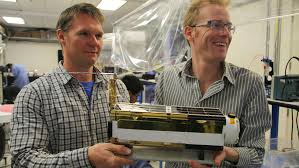Big Ideas in Geospatial Intelligence: Smallsats
Anonym
The small satellite (Smallsat) revolution is fostering big ideas on how we should view the future of geospatial intelligence from a persistence point of view. First off, let’s define what we mean by small so that we can fully appreciate the scale of this new reality in earth imaging. The 2014 SpaceWorks© Nano/Microsatellite market assessment defines five different Smallsat classes on the basis of weight: at the small-end of the spectrum are the Femtosatellites (10-100 grams) and at the heavy-end of the ranges are the Small Satellites (100-500 kilograms). Think of professional boxers weight classes with the “Femtos” being the Pinweights and the “Smalls” being the Featherweights of the group. For earth imaging purposes the majority of the satellites will be Nanosatellites (1-10 kg) – think of Planet Labs as the Light Bantamweights of the global geospatial Smallsat arena (Figure 1).

Figure 1. In this corner in the striped trunks are the challengers: Planet lab co-founders with a Flock 1 Nanosatellite (Planet Labs image)
Spaceworks estimates that by 2020 around 2,750 nano/microsatellites will have launched with the majority having some type of earth imaging sensor on them i.e. electro-optical or radar sensor. With that many looks at the earth is there any wonder that the geospatial intelligence community is jacked-up about the future of persistence? The ultimate success of this new paradigm is going to be seeing your kid dial-up an fresh image on their Smartphone when the family wants to know if the beach is crowded. What will the market look like at that point in time? Perhaps Google, Amazon, IBM and MicroSoft owning 90% of the Smallsat images raining down from space. Then what? Tune in next time for the rest of that story.